Paul Petro in his current gallery at 980 Queen Street W, Toronto. Photo: Phil Anderson
Interview with Paul Petro (PP) on the occasion of celebrating 30 years of Paul Petro Contemporary Art with Phil Anderson (PA) / Part I
PA: First of all, congratulations Paul on this milestone. Can you tell us about your beginnings as an artist and curator in Toronto?
PP: Thank you. As a native of Toronto, and with an artistic bent from early on, the city enabled a process of discovery that offered lots of ways to satisfy one’s curiosity. So did the countryside. My earliest reference for the sensation of being ‘bent’ dates back to a moment up north when my great-aunt lifted down a piece of driftwood from the kitchen wall in her cottage and extended it towards my four-year-old eyes, exclaiming, “look Paul, a great blue heron!”. The moment was thrilling and is etched in my mind. The idea of seeing something in something felt transformational, particularly in the context of summers spent swimming and exploring the natural world. Thus began a journey of seeing things. Decades later, it is the same cottage that I inhabit and call my own, driftwood and all. In a synchronous moment in 2000 (as I discover in this moment of writing), a survey of paintings by Southern Ontario artist Gary Evans, a longstanding artist with the gallery, was given the title Seeing Things. There is something about being returned to one’s childhood again and again that becomes indelible over time. Ask my closest friends. They have all heard this story before.
Stuart Reid, Nell Tenhaaf: Gary Evans, Seeing Things, book cover, 2000
My high school and university years were filled with sensate experience. At St Michael’s College School I privileged the liberal arts, taking as many courses in literature as was allowed, adding courses in music (the clarinet), art and live theatre. On my own time I picked up the guitar. During my university years at Glendon College (1977-1981) where I pursued an honours BA in English Literature, I managed to spend an eye-opening spring and summer backpacking through Europe, taking the Magic Bus from London to Athens, island hopping in the Mediterranean for a month and then ferrying from Corfu to Brindisi, Eurail pass in hand, to follow summer up the continent, through the museums of Italy, Austria, Switzerland, Germany, Belgium, and France, and then back to England (and a birthday party) before returning home. Another summer, a friend and I explored Eastern Canada, driving to New Brunswick, ferrying across to PEI and then cycling around the perimeter of the island. I was also discovering Toronto’s independent live theatre, music, dance and art scenes in earnest, particularly along Queen St West. By the spring of 1981 I had graduated and took over a friend’s loft for the summer in a warehouse at Bathurst and Richmond, before settling into a shared house on Beverley at Queen, and started living in the scene that I had entered. It was during this time that I began to identify as an artist and had mounted a group exhibition in my live/work space, with works by artist friends in the building.
PA: How did you get involved in InterAccess, an artist-run centre, in its early days? How do you think this affected the way you worked as a gallerist later with your own space?
PP: A few blocks west from the loft was the Artculture Resource Centre, or ARC, a multi purpose artist-run centre with an active interest in new technologies. Meetings were taking place there about a new videotex technology called Telidon that was being developed in Canada and was sketching a future filled with information providers (IPs), telebanking and teleshopping, in a rapidly changing televisual landscape. We were learning about field-trial access to the equipment then becoming available and these conversations led to one of the computer terminals, a Norpak IPS2, being installed at Trinity Square Video in August of 1981 so that experimental training workshops could be run on it, providing artists with a device for exploring, creating and storing (on 8-inch floppy disks) computer graphics and text sequences that could augment video production or become interactive works of art in their own right, prompting conversations around this advancing technological structure and its social and psychological implications. I would later receive a grant from the newly-formed Integrated Media section within Media Arts at the Canada Council to pursue work in this area.
Paul Petro, My Media My Self, 1984, videotex still
As artist interest grew it was determined that a basis was there for forming a separate non-profit artist-run centre to provide access and training. I became one of the founding directors and an early general manager of what was then called Toronto Community Videotex, incorporated in March 1983. In 1995 the organization had expanded to include exhibition opportunities in addition to access and training for artists working in electronic media and by 1997 undertook a name change to become InterAccess.
I began producing work and independently curating exhibitions in this eventually short-lived pre-internet medium (it never got the traction that the Canadian Government and Bell Canada had hoped for) which led to curating several online and standalone groups exhibitions at the ARC and A Space in particular, and making interactive videotex works such as My Media My Self (1984) and the award-winning video Canadian Artists and Telidon (1984) while extending my computer graphic work into photography, with identity-driven Pop-inflected works such as His‘n Hers (1984) and Human Enterprise (1985). It was also a period of escalating discussions that included conferences such as Artists Talk About Technology (1984) in Halifax, sponsored by the Association of National Non-Profit Artist Run Centres (ANNPAC) which questioned technological progress, accelerated information dissemination and the human/machine interface at large and in the art-making process, with a host of panels and artist presentations including ones by Sara Diamond and Nell Tenhaaf. The Centre for Culture and Technology through the Faculty of Information at the University of Toronto conducted ongoing Monday night seminars that I was introduced to by Derrick de Kerchove. The seminars offered discussion groups and guest speaker engagements in the spirit of their founder, Marshall McLuhan, who had passed away in 1980, and who (as I paraphrase Norman White here) thought of artists as immunity systems in a world of rapid technological advancement.
Paul Petro, Remember Tomorrow, A Telidon Story, installation view, InterAccess, September 2023
Further into the 1980s I was living in Kensington Market and had a studio at 263A Queen St West where I had begun to push my work in additional directions with a variety of printmaking and curatorial projects focused on exploring the digital/analogue divide. I also joined the Electronic Arts Committee at A Space for the rest of the 1980s and helped facilitate guest lectures, panels, and the curation of exhibitions including The Phase Show (1989) with Doug Back, Hu Hohn and Norman White. At one point in 1986 I found myself named the Toronto spokesperson for the Independent Artists Union (IAU) and attended many meetings, including one at Robert Wiens’s studio in the Chocolate Factory, where we connected the idea of having a living culture with artists having a living wage. Our visibility included marching in the annual Labour Day Parade. All in all, it was an incredibly energizing and formative period of working through ideas in the artist-run sector and led to many involvements that remain ongoing to this day.
Marching in the Labour Day Parade, September 2015 with artists (L-R): Carole Conde, Kim Tomczak, Stan Dennison, Stephen Andrews, John Greyson, Jim Miller, Karl Beveridge, Lisa Steele, Paul Petro, Michelle Gay.
Also in 1986, while between grants, I was told about a job opening at Evelyn Aimis Fine Art, a commercial Yorkville gallery, and was hired and then spent seven years experiencing the art world from that perspective, exhibiting at international art fairs and expediting programming with a roster of Canadian and international artists, while introducing curatorial projects into the mix, such as the group exhibition Body Is A Loaded Word (1987), all the while maintaining my studio practice.
By late 1993 I had left this gallery position and had begun functioning independently once again which led to a stint of programming at 100 Yonge St, in the first of three spaces that would eventually lead to my current gallery at Queen and Ossington, and to a fortieth anniversary origin story exhibition at InterAccess this past September. My early work was included in this group exhibition, Remember the Future – A Telidon Story, much of which hadn’t been seen since a group exhibition at A Space in 1986.
Paul Petro, My Media My Self, installation, A Space, 1986. Photo Cheryl O’Brien (left) and Paul Petro, Human Enterprise and My Media My Self, InterAccess, September, 2023 (right)
Turning 65 this year also brought about a planetary alignment of sorts, not to mention a certain clarity to things anniversary-wise, and that precipitated yet another tote bag being brought into the world: 30 + 40 = 65.
Paul Petro with the tote bag. Photo: Jayne Wilkinson
PA: In the 90’s you operated a gallery at 100 Yonge Street. What kind of programming did you have in that space?
PP: I was friendly with the owners of the building and they generously offered me a window vitrine space on the main floor that opened onto the high-ceilinged granite-clad entrance hall. It had been a challenge to rent (no frontage on Yonge) and I saw it for its guerrilla-programming potential, offering site-specific possibilities for artists by being so embedded in the central business district. Bryan Gee designed the logo banner for 100 Yonge St (he also designed my gallery logo) and announcements would be widely faxed to a list of organizations and individuals. The neighbourhood had hallowed vibes going for it too because Robin Collyer and Shirley Wiitasalo, and General Idea amongst others, had once had studios on the street, and the Silver Rail was further up Yonge, with Sorel Etrog upstairs from there.
Robin Collyer, Value Village, Drugstore, June 1996 at 100 Yonge St
The space was behind a forty-eight-foot-long curtain-wall of glass, fifteen feet high and with a good wall set back four feet from the glass. It came with grey industrial carpeting and a nicely sequenced series of pot lights that I augmented with directional light bulb extension rods. There was a glass door on the far right and a second door in the wall that opened into a drop-ceilinged anteroom and then 2,000 square feet of roughed in and raw windowless space. After several exhibitions on the front wall, I eventually expanded into and programmed the interior spaces. Overall, I was there from late 1994 to early 1997, before opening my next location.
Max Streicher, Stalker. Photo: Max Streicher
In the exhibition Stalker (April, 1995) Max Streicher took his cue from the junior execs roaming the corridors of Bay Street looking for the deals by installing several inflatable hunters and dogs. In Weather Report (December 1996 – January 1997) Peter Bowyer fabricated galvanized steel chairs and tables which echoed the seating of the food court one floor below. I remember Ron Giii showing up at the opening with a box of Hawaiian sprinkle donuts and sitting himself down at one of the tables. Robin Collyer’s Value Village, Drugstore (June 1996) reflected yet another layer of transient on-the-shelf consumer choices so concentrated in the area. And in the exhibition White Pine (November 1996) an environmental work by Robert Wiens brought focus to the threat of clear-cutting old growth forests in Temagami. He installed his first work of the White Pine series, in oil on a 42 x 256 inches length of paper. There was an air of collegial pronouncement as painters including Ric Evans, Jaan Poldaas and Shirley Wiitasalo turned up at the opening, in part to see if the sculptor could indeed paint as well.
Peter Bowyer, Weather Report, galaxies steel and charcoal on paper, December 1996 – January 1997
Group exhibitions included On the Surface of Things (May 1995) with Stephen Andrews, Sheila Butler, Cathy Daley and Tom Dean, Titles and Other Tigers (May 1996) with Millie Chen, Sarinder Dhaliwal and Louise Noguchi, and Sac de Hockey (January 1996), a large and freewheeling exhibition with a host of hockey-playing artists who would regularly rent ice-time together. I proposed a collaborative wall mural on the front wall and devised a locker room for the ‘team’ in a small dropped-ceiling anteroom that preceded the raw space further within. Artists included Carlo Cesta, FASTWÜRMS, Eric Glavin and Lisa Neighbour. I had arranged for a donation of hockey sticks that were handed off to the artists pre-Christmas so that over the holidays the sticks could be worked on and then installed in a locker-room formation along with framed photos of the artists, each taken with the Stanley Cup trophy housed in the nearby Hockey Hall of Fame. In the deeper spaces of the site each artist installed a larger hockey-inspired work. Goalie pads made out of baked bread by James Carl were one of the standouts. We silent-auctioned the hockey sticks on the night of the opening. Hockey player Ken Dryden, who had donated a limited edition print of Paul Henderson scoring the winning goal for Team Canada in 1972, joined us that evening, along with Kaye and Paul Beeston, and my father, whose Toronto Lyndhurst Motors hockey sweater I wore that night. The Lyndhurst Motors represented Canada in 1954 in the first amateur hockey world series to include Russia (we lost to Russia in the final game). Funds raised at the opening were donated to Moss Park Arena at Queen and Sherbourne to purchase hockey helmets for kids in the neighbourhood.
Sac de Hockey exhibition at 100 Yonge St.
It became a tradition for us to move the opening reception up the street to the Silver Rail at Yonge and Shuter. It was across from Massey Hall and had the distinction of being the first bar and cocktail lounge in Toronto to receive a permit from the LLBO, in 1947, to legally serve alcohol. It also held a personal connection in that it was my maternal grandfather who had fabricated and installed the silver rail in the place. 100 Yonge was the setting for a great number of exhibitions by artists that I continued to work with in following years. Some, like Stephen Andrews and Gary Evans continue working with the gallery to this day. It was the same with Michael Morris until his passing in January of this year. Others, including Sheila Butler, Cathy Daley, Rae Johnson, Suzy Lake, Sylvia Safdie and Julie Voyce forged temporary relations with the gallery. Statistically we went on to represent more women artists than most other galleries. Suzy Lake, for one, was with the gallery eighteen years. Other artists like Robin Collyer, John Heward, Gretchen Sankey and Jeannie Thib made guest appearances. In later years, Tom Dean and Robert Wiens circled back. A lot can happen in thirty years.
Stephen Andrews, et-cetera, installation view, 2023. Courtesy of Paul Petro Contemporary Art
Gary Evans, Light Moves, installation view, 2022. Courtesy of Paul Petro Contemporary Art
Tom Dean, Mercy, installation view, 2013, Courtesy of Paul Petro Contemporary Art
PA: When you opened your first gallery on Queen St. West near Duncan it must have been an interesting time to be running a gallery. Can you describe it?
PP: It was an interesting time and an interesting block. I had a studio just east of Duncan at 263A, across the street from the Queen Mother Café. This is where I was also administering to the needs of 100 Yonge which was more or less a standalone space and open by appointment when I wasn’t present. I did have a desk at 100 Yonge. It’s the same desk that is in the work on paper room in my current gallery. Randy and Berenicci were at 257A. David Ramsden lived at the corner, over Price Roman. I had taken over Philip Monk and Shelagh Alexander’s old place. Colin Campbell and John Scott had been previous inhabitants. Lynn Fernie used to live next door, and so on. Cold City Gallery was around the corner. So was Art Metropole. And the Art Gallery of Ontario and OCAD were just up the street.
A block west of the studio was John St, and just north of Queen and John was 179 John St, home to several galleries including the Isaacs Gallery, Jane Corkin Gallery and Klonarides. By 1995 Av had moved out of his high-ceilinged basement location. I had opened 100 Yonge with a series of three monumental landscape paintings by Rae Johnson who had previously shown them at Carmen Lamanna’s Gallery. After Carmen died in 1991 Rae and I had formed a connection. I remember we were standing outside in the mist of a water sculpture by John Dixon in front of Garnet Press Gallery during the opening of Dreaming of You, a farewell to Robert Flack memorial group exhibition. I had a work in the show. I asked Rae about driving up to Flesherton to look at what she was up to, which led to the decision to show some work at 100 Yonge in 1994, curate a show of her paintings at Hart House in 1995, and have a show in Av’s old space. We agreed to show Bambino Miracolo (June 1995) the monumental works Rae had produced in OCAD’s Florence studio. I remember asking Av about the alarm system in the space and he replied, with a glint in his eye, not to worry about it. Nobody wants to steal contemporary Canadian art.
Following Rae’s show I had my first solo exhibition with Cathy Daley in the same space at 179 John, Selected Works (October 1995). We showed her lambent large-scale floating black figures, small triptych works on paper and Dans la nuit, a series of small blue paintings on paper mounted on linen. I had introduced Cathy to my paper conservator and dear friend, Beatrice Stock, who had successfully mounted my large black and white Photostats on linen years earlier, and she helped Cathy out. I had previously seen the large black figures in a show at Cold City and they had held my interest. In the late 1980s I had made my first purchases of contemporary art at Cold City, a shift from trading with friends or receiving as gifts. I bought a small Cathy Daley painting on paper of stockings on a clothesline and a large pastel on black paper by Ron Giii, Mathematicus, from The Dictator’s Opera (1985). We were all lined up to get into their holiday exhibition. I was at the door and Alan Schwartz was next in line. We all made a bee-line for works. Back then everything seemed to be in the same neighbourhood, the M5V. There was even an M5V Magazine published by Eldon Garnet and Impulse which lasted three issues, Summer 1991 to Spring 1992. The art community was small and bracingly informed back then.
Ron Giii, Mathematicus, from The Dictator’s Opera
As my programming at 100 Yonge St was evolving, I started considering the exhibition possibilities in the space of my studio. I can recall gallerist Fela Grunwald being in the studio and predicting that if I’m not careful I might just open a gallery one day. I already knew that I wasn’t interested in joining the curatorial department of a public institution and relinquishing control of my programming schedule. I also knew it would be a lot of work reducing my studio into a smaller space.
The building block where Paul Petro Contemporary Art was located at Queen St W and Duncan, left to Subway, 2022. Photo: Paul Petro
One advantage that I had at the time was that my landlord, who owned the three adjacent walk-ups, also owned a warehouse around the corner at 176 John St, across from 179. He found me a space on the top floor, much smaller than my studio but manageable enough for the scale of work I was making. I took the space and, with some ingenuity, set up my printing table and moved all of my works and materials, shelving and racks, making the most of a smaller space. Meanwhile, back at my larger studio, I had learned that the upper floors of the building next door at 265A were becoming available. When I had originally taken my studio at 263A I had rented the second floor out to friends and had kept the third floor as a studio. I decided to relinquish my third-floor space and make the move next door, creating storage in the front rooms and reception in the exposed brick back area of the second floor. There was a walkout to the rear roof from there. Stairs from reception led to an open third floor which worked well as a sizeable exhibition space, complete with a walk-through to a small work on paper room at the back that could house my two sets of print drawers. It was a short enough move (perfect for the human chain we formed on moving day). A continuous coat of frost grey floor enamel on all floors and stairs, and white-painted walls, bannisters, moldings and salvaged track lighting clarified the space and brought the gallery qualities into focus. When Rae Johnson first came over, she declared the new space a sculpture. Her exhibition Winter Paintings (March 1997) would open shortly after.
Rae Johnson: Winter Angel, oil and graphite on canvas, 51 x 51 inches
My last exhibition at 100 Yonge St was Exquisite ChromaZone (February 1997), featuring formative and current work by the original ChromaZone members, Andy Fabo, Oliver Girling, Sybil Goldstein, Rae Johnson, H.P. Marti and Tony Wilson. The anteroom space of the exhibition included a chronology of original exhibition posters, catalogues and ephemera from the ChromaZone period in Toronto (1981-1984), and photographs of the people and events of the time. The front wall of the site had four exquisite corpse drawings on 96 x 48 inches sheets of paper. The four works were collaborations by Andy, Oliver, Sybil and Rae, and were each installed in the front window space with a layer of brown kraft paper covering them. We had an unveiling at the opening reception. The works wound up in the collection of the Art Gallery of Mississauga where Stuart Reid was then the curator. I’d love to have included an image of the installation but as of this writing my photo-documentation is still in file folders and boxes, undisturbed since that time. Scanning all of these images is an eventuality. So much of broader life was pre digital at the time.
Paul Petro in his gallery. Photo: Phil Anderson
*Paul Petro Contemporary Art, 980 Queen Street W, Toronto. Gallery hours: Wed – Sat, 11 – 5 p.m.

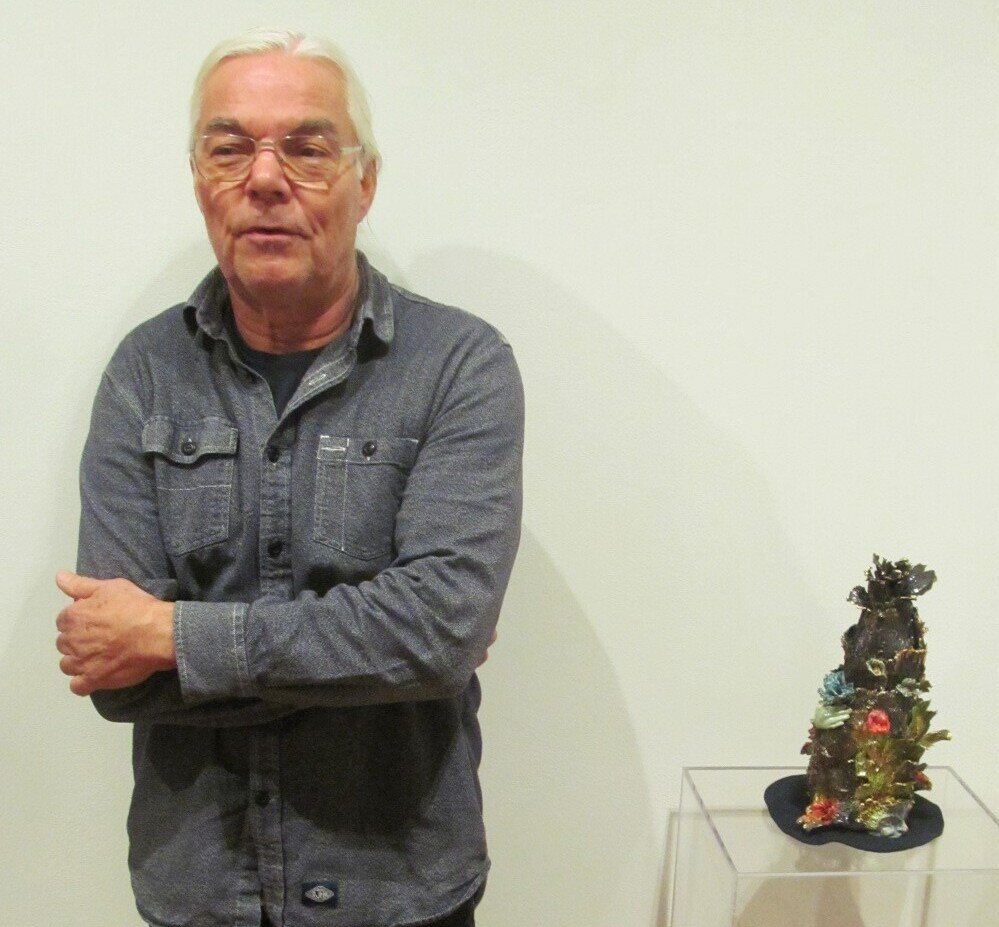
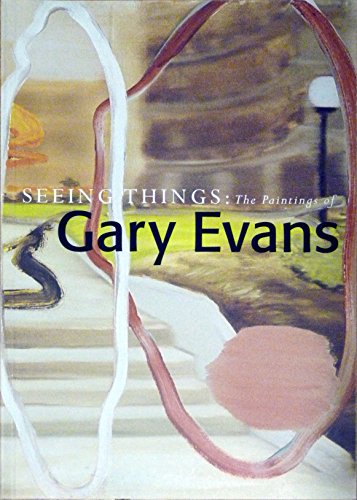
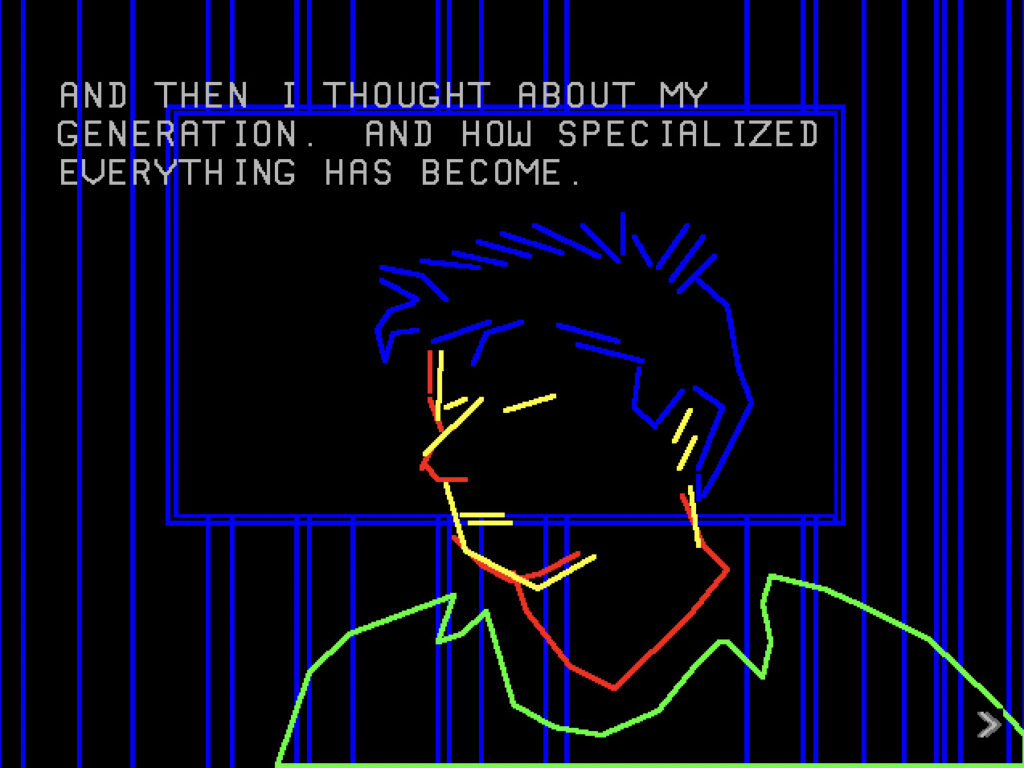
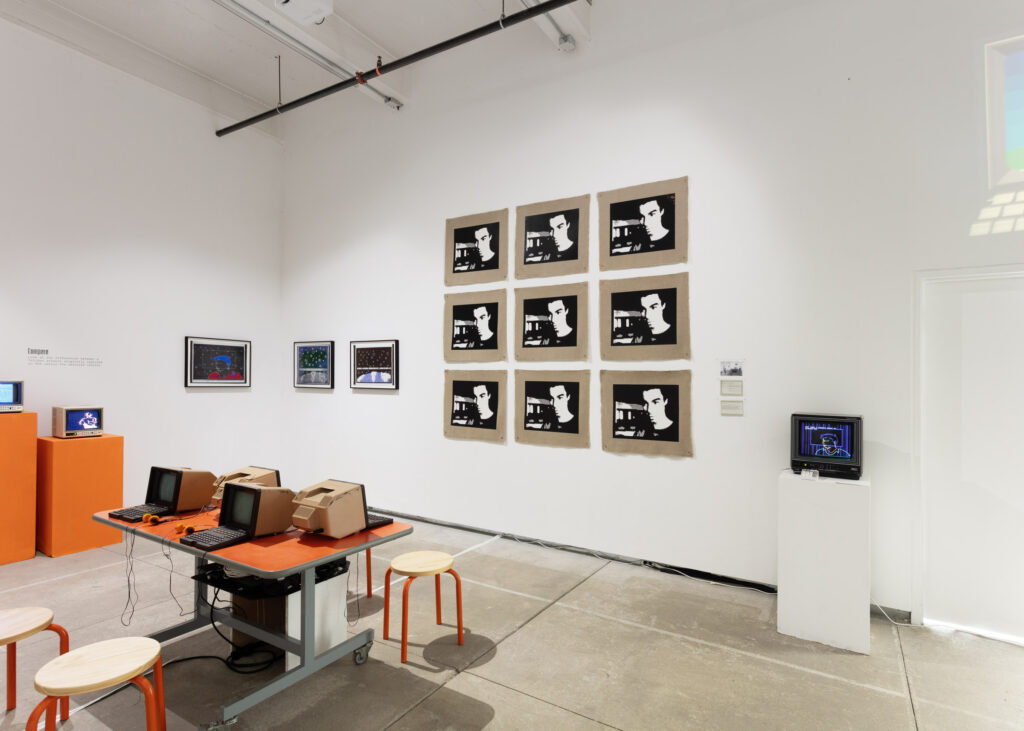
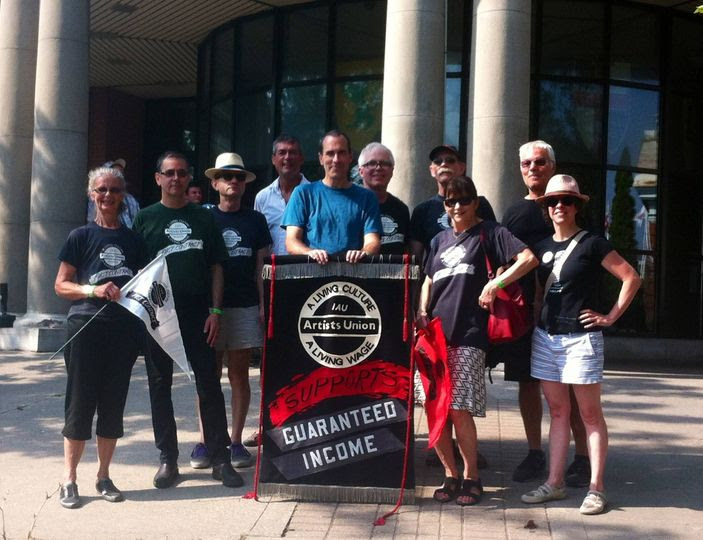

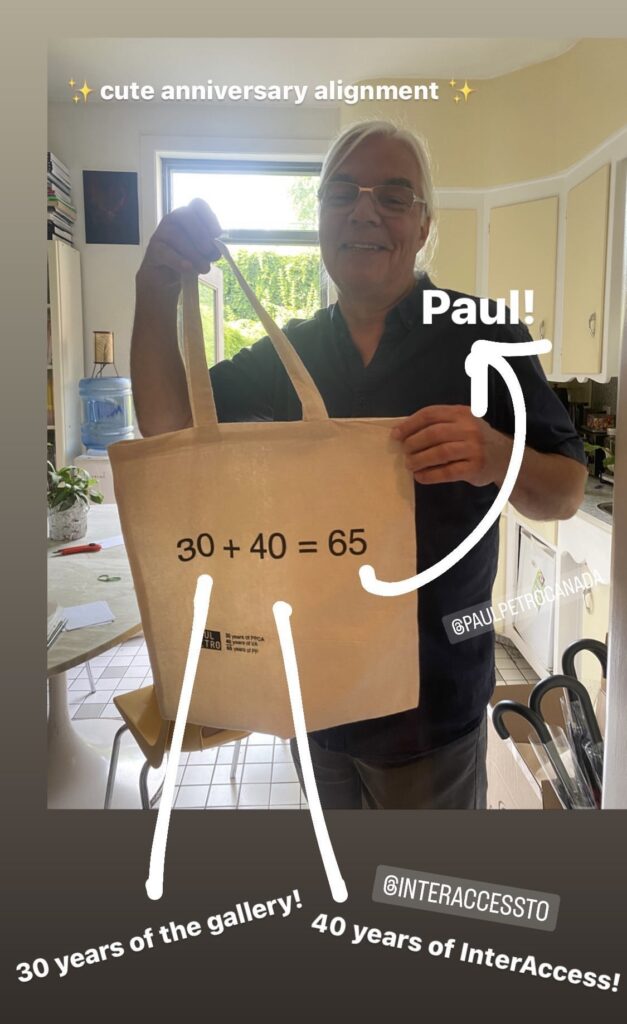
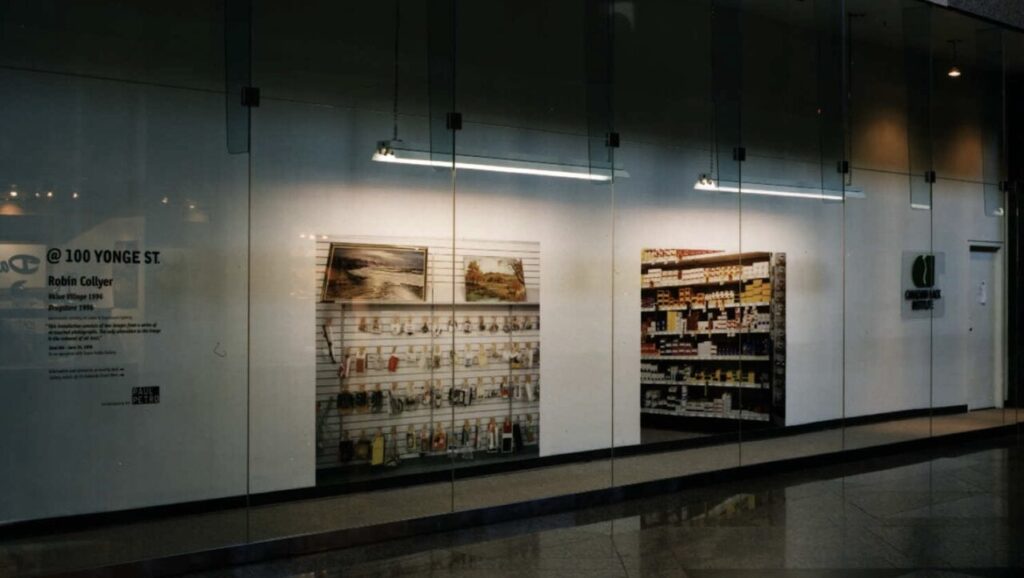
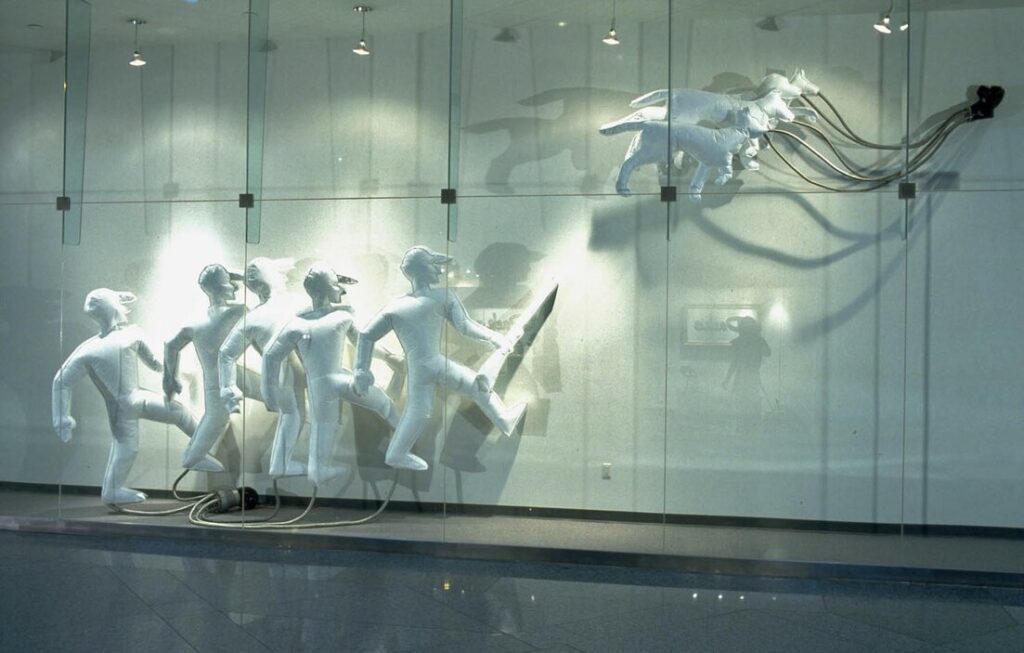
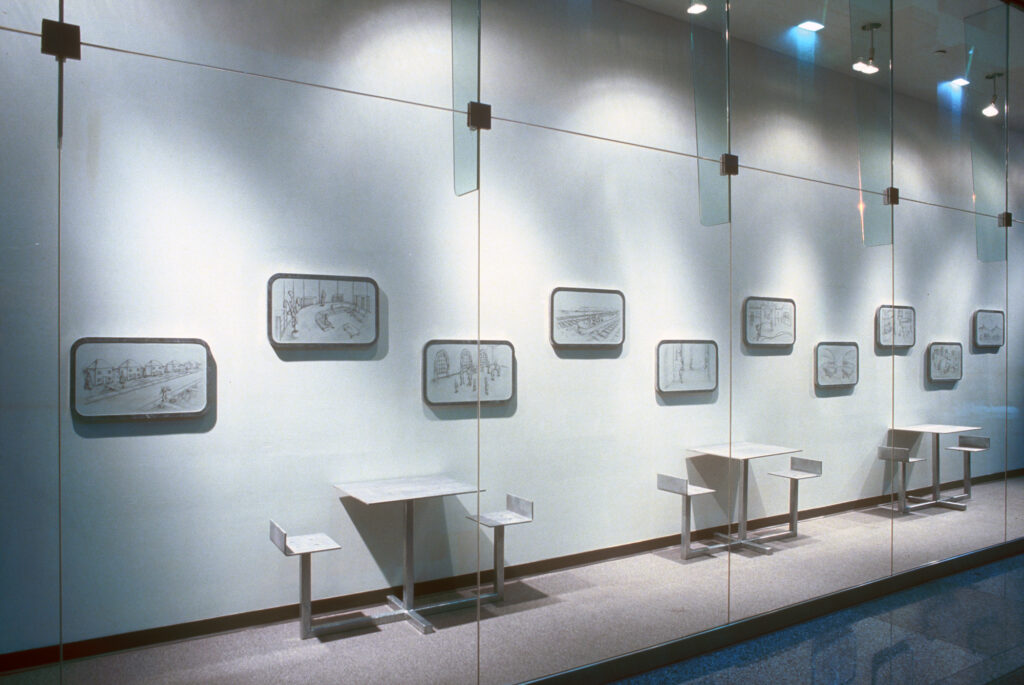
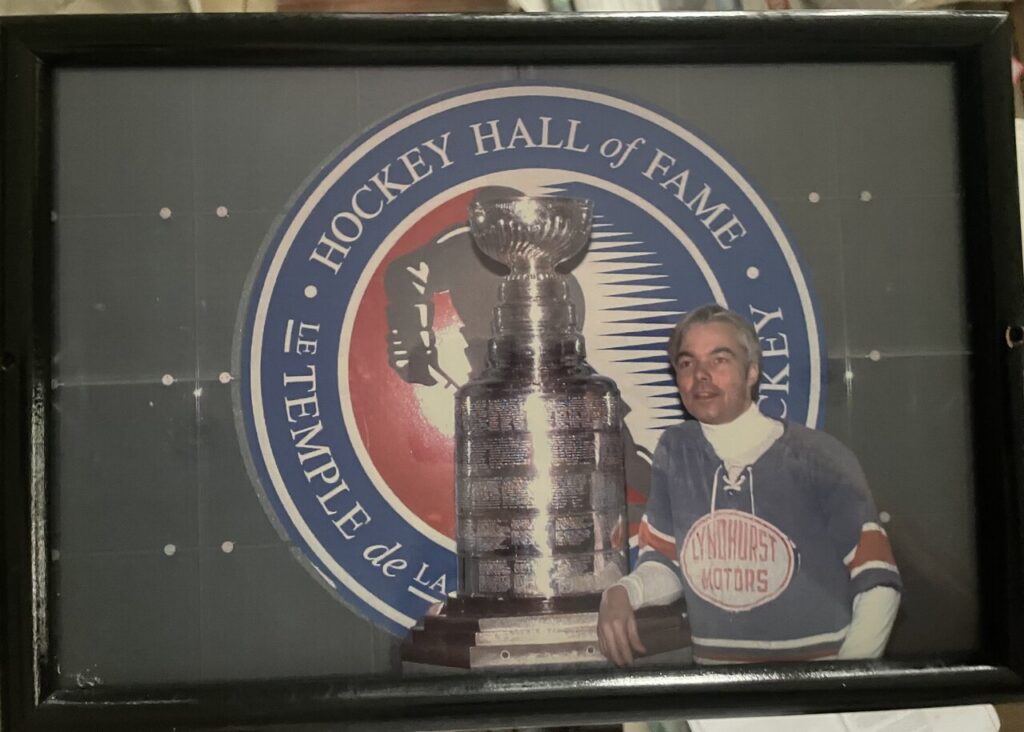
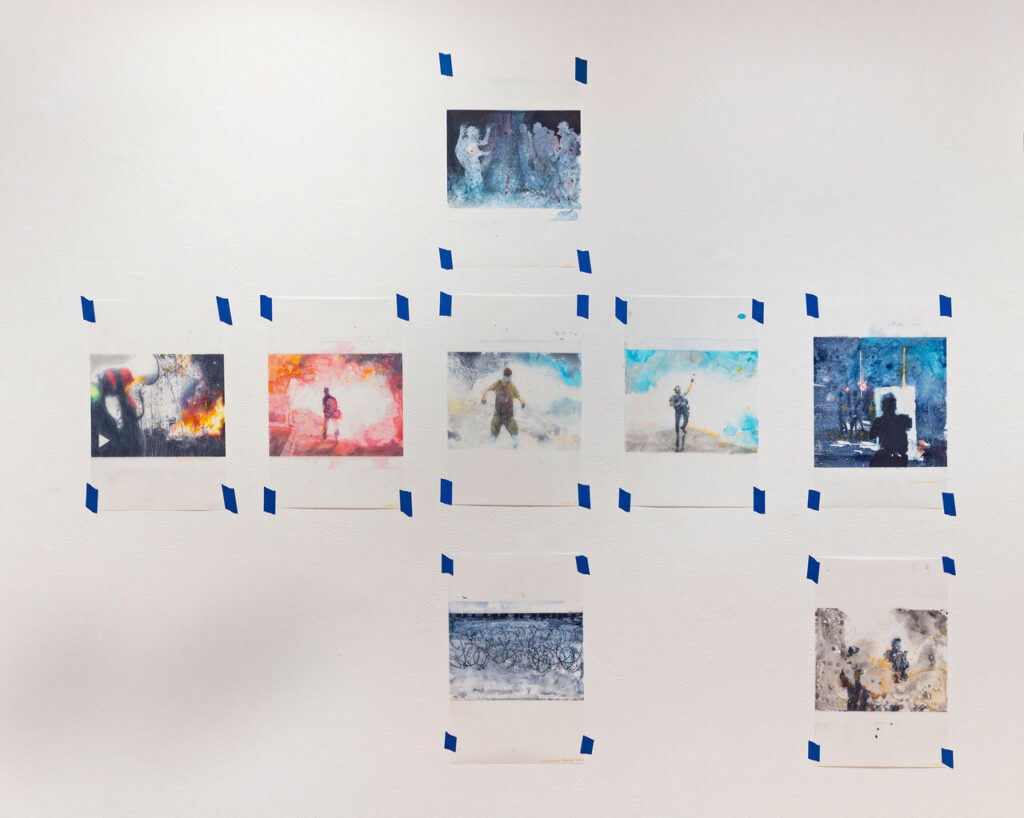
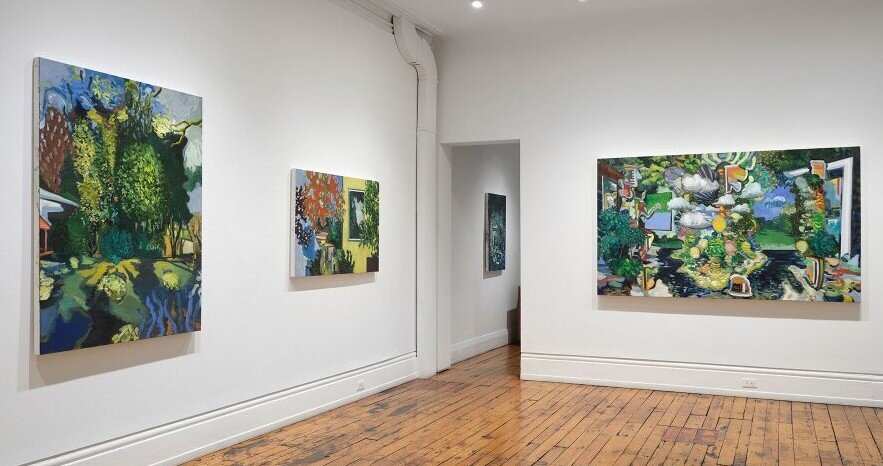
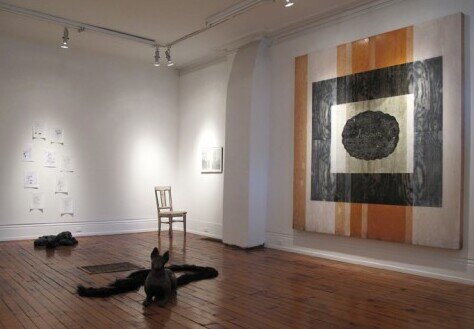
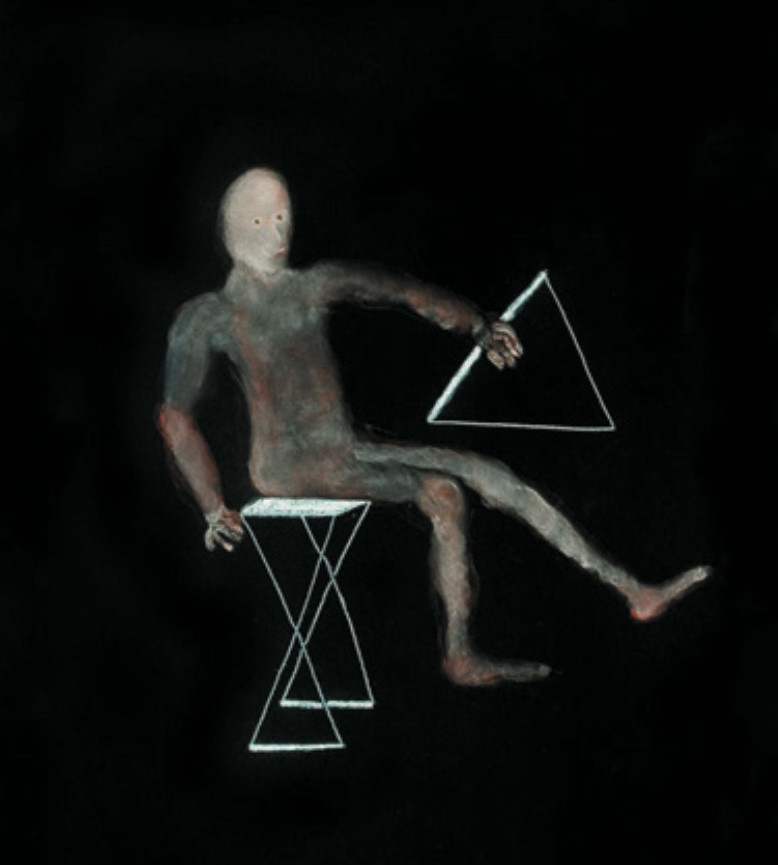
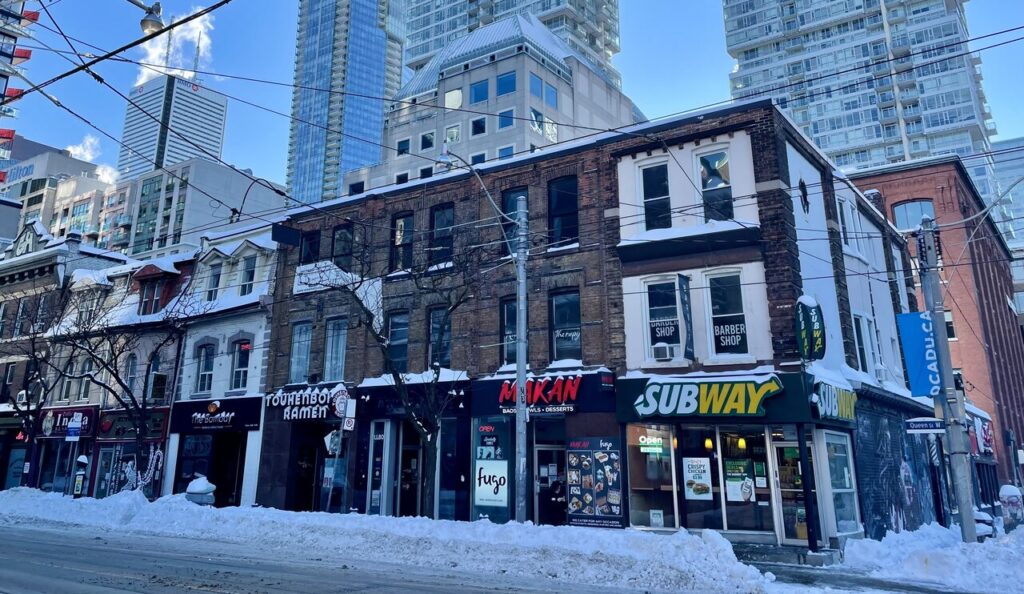

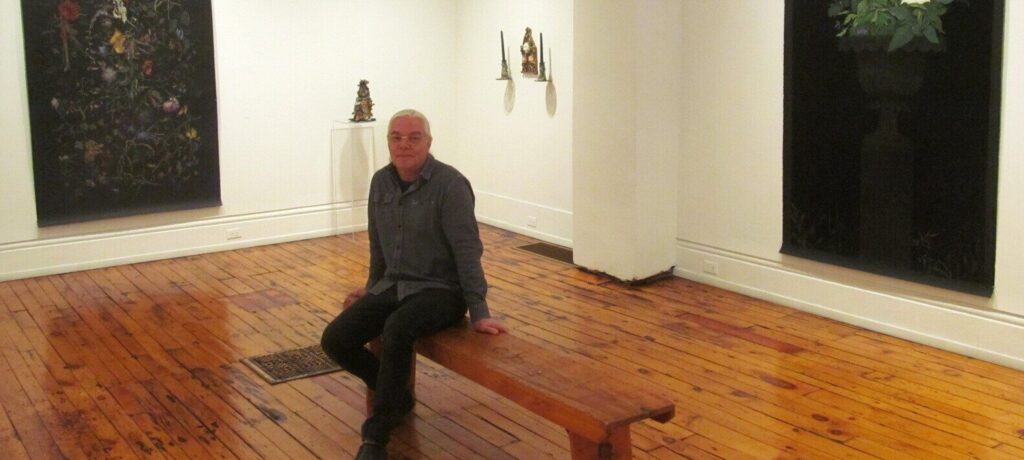
Happy anniversary! So great to read this history! Thank you for writing it. Many good memories and much that is new to me (e.g., your founding relationship to Inter Access.) Not sure why you heard my voice while writing, as you confessed, but if it prompted you to write, I’m delighted. Also wonderful to see the images, and hope the others still in file folders and boxes will emerge and be digitized before too long.
It is great to still have Paul Petro And his Gallery around the city. Is a great asset for the community.
Congratulations Paul on 30 years of PPCA! Your dedication to curating and exhibiting Canadian (mostly), contemporary art has solidly placed artists, collectors, educators and the public together in continuum as a rich and thriving community. Thank you for everything you do!